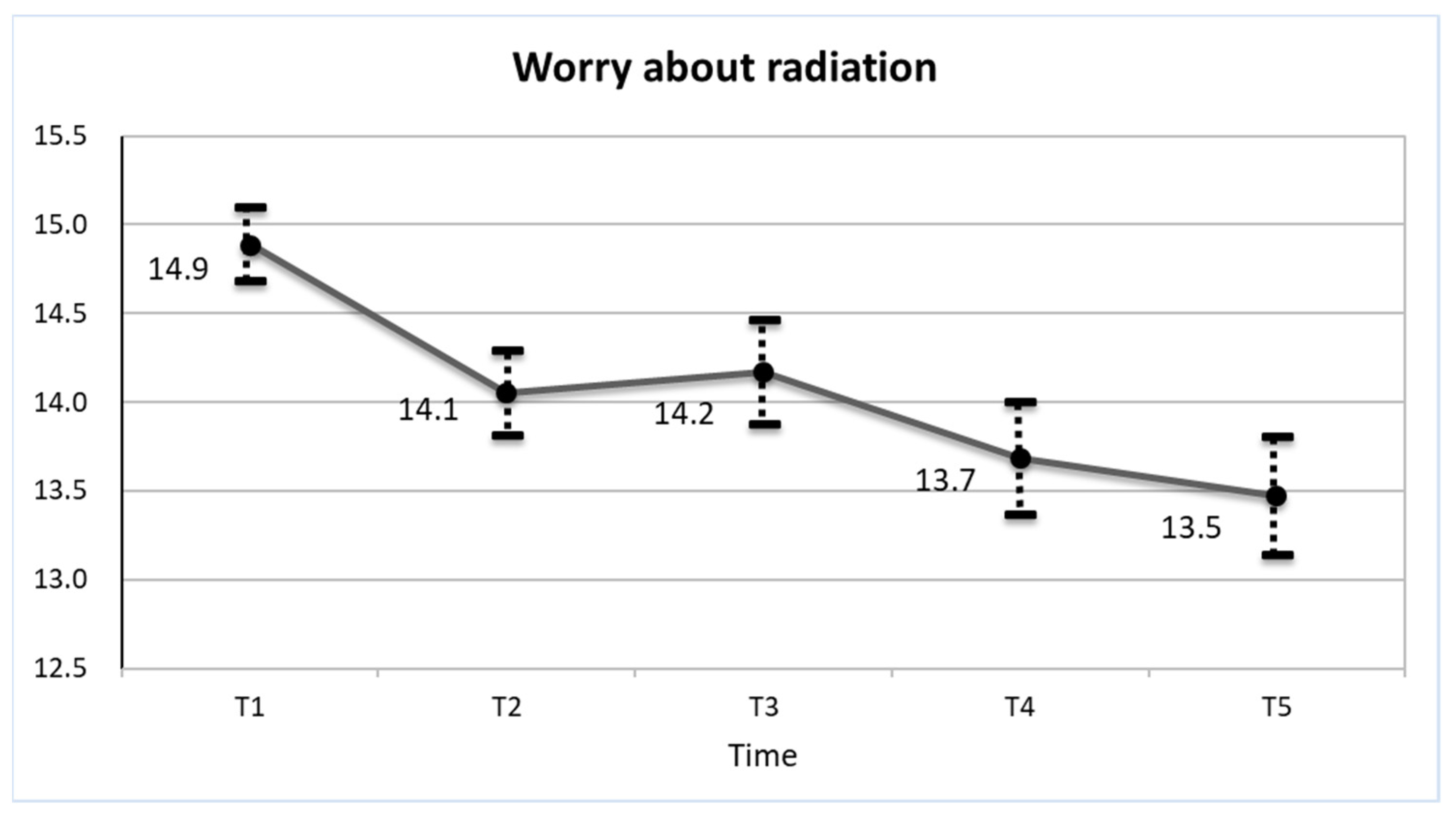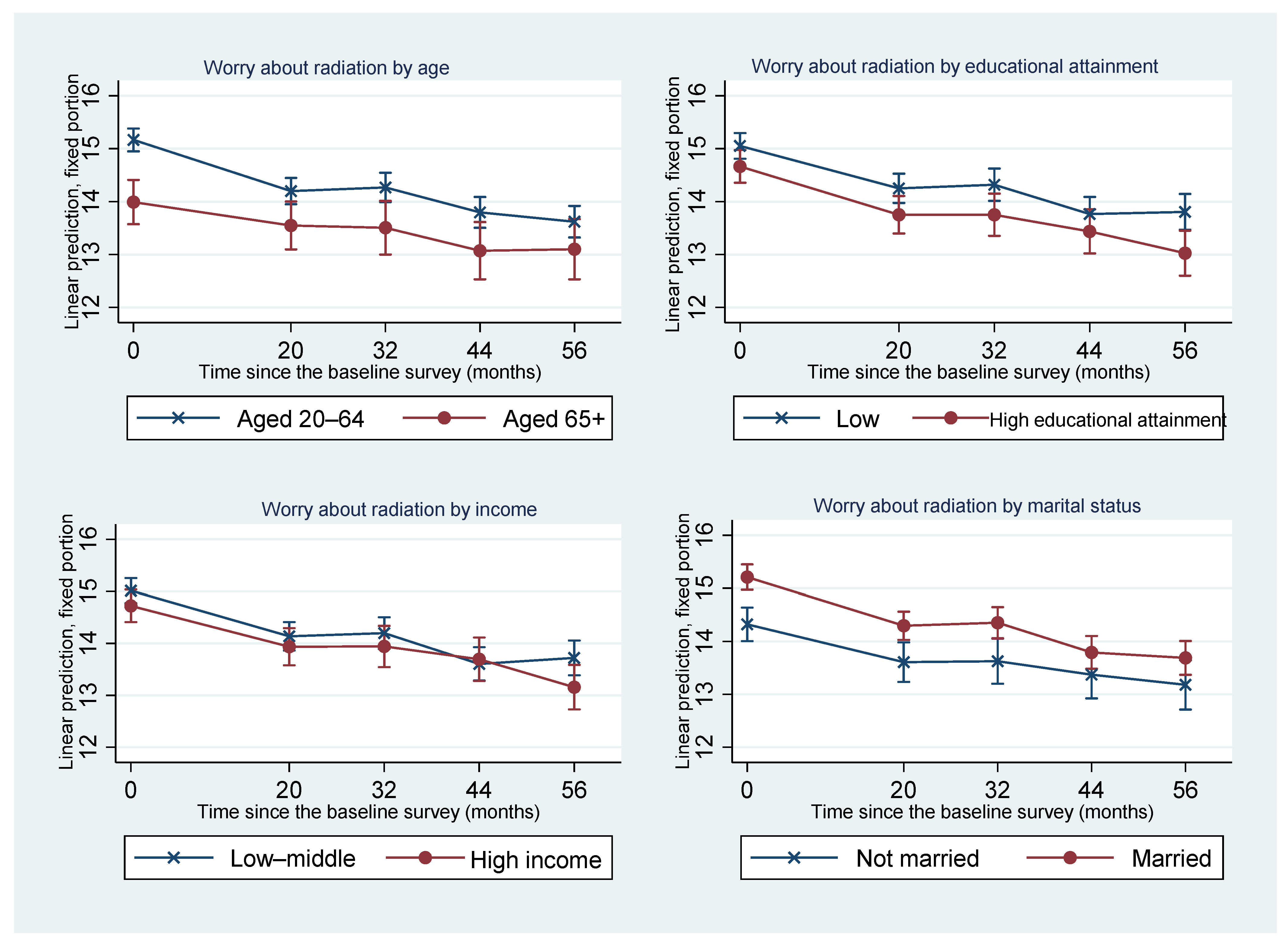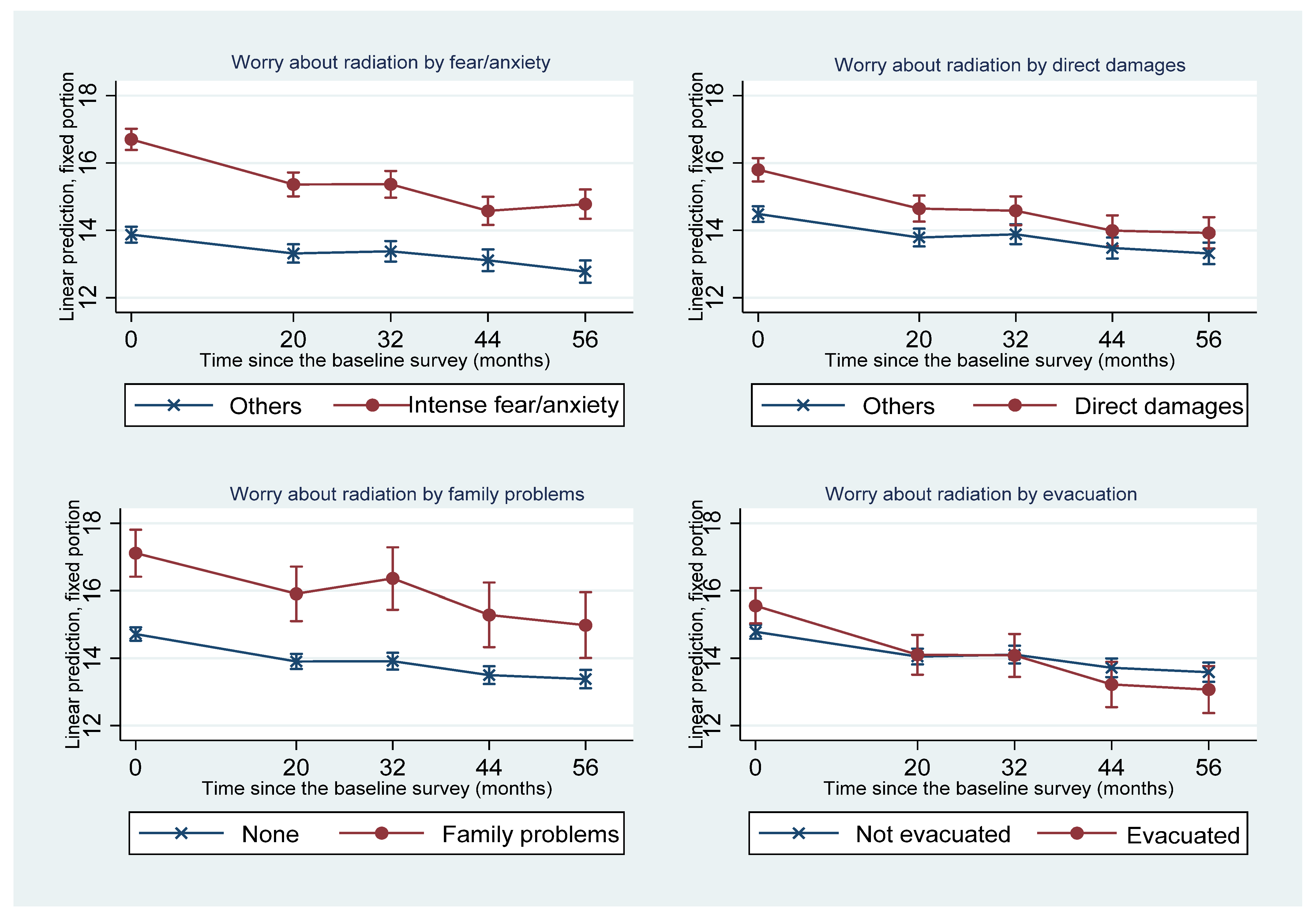Worry about Radiation and Its Risk Factors Five to Ten Years after the Fukushima Nuclear Power Plant Disaster
Abstract
1. Introduction
2. Materials and Methods
2.1. Study Design and Population
2.2. Study Variables
2.2.1. Worry about Radiation
2.2.2. Sociodemographic Characteristics
2.2.3. Disaster-Related Experiences
- Fear or anxiety immediately after the nuclear power plant accident;
- Direct damage caused by the disaster;
- Disaster-related family problems;
- Evacuation to avoid radiation exposure.
2.3. Statistical Analysis
3. Results
4. Discussion
5. Conclusions
Supplementary Materials
Author Contributions
Funding
Institutional Review Board Statement
Informed Consent Statement
Data Availability Statement
Conflicts of Interest
References
- Adams, R.E.; Guey, L.T.; Gluzman, S.F.; Bromet, E.J. Psychological wellbeing and risk perceptions of mothers in Kyiv, Ukraine, 19 years after the Chornobyl disaster. Int. J. Soc. Psychiatry 2011, 57, 637–645. [Google Scholar] [CrossRef] [PubMed]
- Bromet, E.J.; Litcher-Kelly, L. Psychological responses of mothers of young children to the Three Mile Island and Chernobyl nuclear plant accidents one decade later. In Toxic Turmoil: Psychological and Societal Consequences of Ecological Disasters; Havenaar, J.M., Cwikel, J.G., Bromet, E.J., Eds.; Springer—Science+Business Media: New York, NY, USA, 2002; pp. 69–84. [Google Scholar]
- Dew, M.A.; Bromet, E.J. Predictors of temporal patterns of psychiatric distress during 10 years following the nuclear accident at Three Mile Island. Soc. Psychiatry Psychiatr. Epidemiol. 1993, 28, 49–55. [Google Scholar] [CrossRef] [PubMed]
- Goldsteen, R.; Schorr, J.K.; Goldsteen, K.S. Longitudinal study of appraisal at Three Mile Island: Implications for life event research. Soc. Sci. Med. 1989, 28, 389–398. [Google Scholar] [CrossRef]
- Fukasawa, M.; Kawakami, N.; Umeda, M.; Miyamoto, K.; Akiyama, T.; Horikoshi, N.; Yasumura, S.; Yabe, H.; Bromet, E.J. Environmental radiation level, radiation anxiety, and psychological distress of non-evacuee residents in Fukushima five years after the Great East Japan Earthquake: Multilevel analyses. SSM Popul. Health 2017, 3, 740–748. [Google Scholar] [CrossRef]
- Fukasawa, M.; Kawakami, N.; Umeda, M.; Akiyama, T.; Horikoshi, N.; Yasumura, S.; Yabe, H.; Suzuki, Y.; Bromet, E.J. Longitudinal associations of radiation risk perceptions and mental health among non-evacuee residents of Fukushima prefecture seven years after the nuclear power plant disaster. SSM Popul. Health 2020, 10, 100523. [Google Scholar] [CrossRef] [PubMed]
- Oe, M.; Maeda, M.; Nagai, M.; Yasumura, S.; Yabe, H.; Suzuki, Y.; Harigane, M.; Ohira, T.; Abe, M. Predictors of severe psychological distress trajectory after nuclear disaster: Evidence from the Fukushima health management survey. BMJ Open 2016, 6, e013400. [Google Scholar] [CrossRef] [PubMed]
- Oe, M.; Takahashi, H.; Maeda, M.; Harigane, M.; Fujii, S.; Miura, I.; Nagai, M.; Yabe, H.; Ohira, T.; Suzuki, Y.; et al. Changes of posttraumatic stress responses in evacuated residents and their related factors. Asia Pac. J. Public Heal. 2017, 29, 182S–192S. [Google Scholar] [CrossRef] [PubMed]
- Suzuki, Y.; Yabe, H.; Yasumura, S.; Ohira, T.; Niwa, S.-I.; Ohtsuru, A.; Mashiko, H.; Maeda, M.; Abe, M. Psychological distress and the perception of radiation risks: The Fukushima Health Management Survey. Bull. World Health Organ 2015, 9, 598–605. [Google Scholar] [CrossRef] [PubMed]
- Niitsu, T.; Takaoka, K.; Uemura, S.; Kono, A.; Saito, A.; Kawakami, N.; Nakazato, M.; Shimizu, E. The psychological impact of a dual-disaster caused by earthquakes and radioactive contamination in Ichinoseki after the Great East Japan Earthquake. BMC Res. Notes 2014, 7, 307. [Google Scholar] [CrossRef] [PubMed]
- Murakami, M.; Nakatani, J.; Oki, T. Evaluation of risk perception and risk-comparison information regarding dietary radionuclides after the 2011 Fukushima Nuclear Power Plant Accident. PLoS ONE 2016, 11, e0165594. [Google Scholar] [CrossRef] [PubMed]
- Suzuki, Y.; Takebayashi, Y.; Yasumura, S.; Murakami, M.; Harigane, M.; Yabe, H.; Ohira, T.; Ohtsuru, A.; Nakajima, S.; Maeda, M. Changes in risk perception of the health effects of radiation and mental health status: The Fukushima Health Management Survey. Int. J. Environ. Res. Public Health 2018, 15, 1219. [Google Scholar] [CrossRef] [PubMed]
- Kawakami, N. Research for monitoring changes of radiation health anxiety in evacuees and non-evacuees and promoting the countermeasures through gatekeeper training in the Fukushima Prefecture. In Research on the Health Effects of Radiation Organized; Ministry of the Environment: Tokyo, Japan, 2021; Available online: https://www.env.go.jp/chemi/rhm/reports.html (accessed on 17 July 2021). (In Japanese)
- Radiation Medical Science Center for the Fukushima Health Management Survey, Fukushima Medical University. Report on the Fukushima Health Management Survey—Mental Health and Lifestyle Survey. 5. Jisshi-jyokyo. Fiscal year Reiwa-1. No. 42. Shiryo 2-1. Available online: http://www.pref.fukushima.lg.jp/site/portal/kenkocyosa-kokoro.html (accessed on 8 March 2022). (In Japanese).
- Radiation Medical Science Center for the Fukushima Health Management Survey, Fukushima Medical University. Report of the Fukushima Health Management Survey 2011–2020. Available online: http://kenko-kanri.jp/en/img/10yr_report_full_en.pdf (accessed on 11 March 2022).
- Fukasawa, M.; Kawakami, N.; Umeda, M.; Akiyama, T.; Horikoshi, N.; Yasumura, S.; Yabe, H.; Suzuki, Y.; Bromet, E.J. Long-lasting effects of distrust in government and science on mental health eight years after the Fukushima nuclear power plant disaster. Soc. Sci. Med. 2020, 258, 113108. [Google Scholar] [CrossRef] [PubMed]
- Umeda, M.; Sekiya, Y.; Kawakami, N.; Miyamoto, K.; Horikoshi, N.; Yabe, H.; Yasumura, S.; Ohtsuru, A.; Akiyama, T.; Suzuki, Y. Reliability and validity of radiation anxiety scale developed for Fukushima community residents. In Proceedings of the 24th Annual Scientific Meeting of the Japan Epidemiological Association, Sendai, Japan, 23–25 January 2014. (In Japanese). [Google Scholar]
- Kawakami, N. Study on the radiation health anxiety in Fukushima prefecture and the development of the effective countermeasures. In The Study of the Health Effects of Radiation organized; Japanese Ministry of the Environment: Tokyo, Japan, 2013. (In Japanese) [Google Scholar]
- Dai, W.; Chen, L.; Tan, H.; Wang, J.; Lai, Z.; Kaminga, A.C.; Li, Y.; Liu, A. Association between social support and recovery from post-traumatic stress disorder after flood: A 13–14 year follow-up study in Hunan, China. BMC Public Health 2016, 16, 194. [Google Scholar] [CrossRef] [PubMed]
- Orui, M.; Nakayama, C.; Moriyama, N.; Tsubokura, M.; Watanabe, K.; Nakayama, T.; Sugita, M.; Yasumura, S. Current psychological distress, post-traumatic stress, and radiation health anxiety remain high for those who have rebuilt permanent homes following the Fukushima Nuclear Disaster. Int. J. Environ. Res. Public Health 2020, 17, 9532. [Google Scholar] [CrossRef]
- Rusch, H.L.; Shvil, E.; Szanton, S.L.; Neria, Y.; Gill, J.M. Determinants of psychological resistance and recovery among women exposed to assaultive trauma. Brain Behav. 2015, 5, e00322. [Google Scholar] [CrossRef] [PubMed]
- Alim, T.N.; Feder, A.; Graves, R.E.; Wang, Y.; Weaver, J.; Westphal, M.; Alonso, A.; Aigbogun, N.U.; Smith, B.W.; Doucette, J.T.; et al. Trauma, resilience, and recovery in a high-risk African-American population. Am. J. Psychiatry 2008, 165, 1566–1575. [Google Scholar] [CrossRef] [PubMed]



| n | %/SD | ||||
|---|---|---|---|---|---|
| Sociodemographic characteristics | |||||
| Age, years | |||||
| 20–39 | 804 | 44.1 | |||
| 40–64 | 612 | 33.5 | |||
| 65+ | 409 | 22.4 | |||
| Mean (Standard Deviation) | 47.1 | (17.3) | |||
| Sex | |||||
| Men | 859 | 47.1 | |||
| Women | 966 | 52.9 | |||
| Educational attainment | |||||
| Up to high school | 1127 | 61.8 | |||
| Junior or technical college or higher | 698 | 38.3 | |||
| Annual household income | |||||
| Low (Less than JPY 250 million) | 430 | 23.6 | |||
| Middle (JPY 250–500 million) | 724 | 39.7 | |||
| High (JPY 500 million or more) | 671 | 36.8 | |||
| Marital status | |||||
| Married | 1159 | 63.5 | |||
| Separated, divorced, bereaved, unmarried, or unknown | 666 | 36.5 | |||
| Residential area | |||||
| Eastern coastal area (Hama-dori) | 138 | 7.6 | |||
| Central area (Naka-dori) | 1009 | 55.3 | |||
| Western mountainous area (Aizu) | 678 | 37.2 | |||
| Disaster-related experiences | |||||
| Fear or anxiety immediately after the accident | |||||
| None to moderate | 1166 | 63.9 | |||
| Intense | 659 | 36.1 | |||
| Direct damage (ref. none) | |||||
| Injured | 14 | 0.8 | |||
| Family member injured or dead | 79 | 4.3 | |||
| Loss of job or temporary absence from work | 260 | 14.3 | |||
| Loss of house or property | 359 | 19.7 | |||
| Cumulative damage | |||||
| 0 | 1252 | 68.6 | |||
| 1 | 449 | 24.6 | |||
| 2+ | 124 | 6.8 | |||
| Disaster-related family problems (ref. none) | |||||
| Deterioration of family relationships | 68 | 3.7 | |||
| Family separation | 96 | 5.3 | |||
| Cumulative damage | |||||
| 0 | 1681 | 92.1 | |||
| 1+ | 144 | 7.9 | |||
| Evacuation to avoid radiation exposure | |||||
| Not evacuated | 1556 | 85.3 | |||
| Evacuated | 269 | 14.7 | |||
| Bivariate Associations | Model 1 | Model 2 | |||||||||
|---|---|---|---|---|---|---|---|---|---|---|---|
| Coef. | SE | p | AdjustedCoef. | SE | p | AdjustedCoef. | SE | p | |||
| Time (month) | −0.03 | 0.00 | <0.001 | −0.03 | 0.00 | <0.001 | −0.01 | 0.00 | 0.027 | ||
| Sociodemographic characteristics | |||||||||||
| Age (65+) | −0.81 | 0.22 | <0.001 | −0.88 | 0.21 | <0.001 | −1.10 | 0.23 | <0.001 | ||
| Sex (women) | −0.11 | 0.19 | 0.554 | −0.35 | 0.17 | 0.034 | −0.35 | 0.17 | 0.032 | ||
| Educational attainment (junior or technical college or higher) | −0.30 | 0.19 | 0.115 | −0.47 | 0.18 | 0.009 | −0.41 | 0.20 | 0.034 | ||
| Household income (high) | −0.12 | 0.19 | 0.534 | −0.25 | 0.18 | 0.151 | −0.30 | 0.19 | 0.127 | ||
| Marital status (married) | 0.68 | 0.19 | <0.001 | 0.74 | 0.18 | <0.001 | 0.87 | 0.20 | <0.001 | ||
| Residential area (eastern coastal area or central area) | 1.91 | 0.19 | <0.001 | 1.27 | 0.18 | <0.001 | 1.27 | 0.18 | <0.001 | ||
| Disaster-related experiences (ref. none) | |||||||||||
| Fear or anxiety immediately after the accident (intense) | 2.74 | 0.18 | <0.001 | 2.30 | 0.18 | <0.001 | 2.60 | 0.19 | <0.001 | ||
| Direct damage | 1.88 | 0.19 | 0.001 | 0.97 | 0.19 | <0.001 | 1.18 | 0.21 | <0.001 | ||
| Disaster-related family problems | 3.41 | 0.34 | <0.001 | 2.18 | 0.33 | <0.001 | 2.09 | 0.36 | <0.001 | ||
| Evacuation to avoid radiation | 1.96 | 0.26 | <0.001 | 0.25 | 0.26 | 0.337 | 0.61 | 0.28 | 0.030 | ||
| Interaction of the time and sociodemographic characteristics | |||||||||||
| Time×Age (65+) | 0.01 | 0.01 | 0.041 | ||||||||
| Time×Educational attainment (junior or technical college or higher) | 0.00 | 0.00 | 0.606 | ||||||||
| Time×Household income (high) | 0.00 | 0.00 | 0.589 | ||||||||
| Time×Marital status (married) | −0.01 | 0.00 | 0.110 | ||||||||
| Interaction of the time and disaster-related experiences | |||||||||||
| Time×Fear or anxiety immediately after the accident (intense) | −0.02 | 0.00 | 0.001 | ||||||||
| Time×Direct damage | −0.01 | 0.00 | 0.014 | ||||||||
| Time×Disaster-related family problems | 0.00 | 0.01 | 0.570 | ||||||||
| Time×Evacuation to avoid radiation exposure | −0.02 | 0.01 | 0.002 | ||||||||
Publisher’s Note: MDPI stays neutral with regard to jurisdictional claims in published maps and institutional affiliations. |
© 2022 by the authors. Licensee MDPI, Basel, Switzerland. This article is an open access article distributed under the terms and conditions of the Creative Commons Attribution (CC BY) license (https://creativecommons.org/licenses/by/4.0/).
Share and Cite
Fukasawa, M.; Umeda, M.; Akiyama, T.; Horikoshi, N.; Yasumura, S.; Yabe, H.; Suzuki, Y.; Bromet, E.J.; Kawakami, N. Worry about Radiation and Its Risk Factors Five to Ten Years after the Fukushima Nuclear Power Plant Disaster. Int. J. Environ. Res. Public Health 2022, 19, 16943. https://doi.org/10.3390/ijerph192416943
Fukasawa M, Umeda M, Akiyama T, Horikoshi N, Yasumura S, Yabe H, Suzuki Y, Bromet EJ, Kawakami N. Worry about Radiation and Its Risk Factors Five to Ten Years after the Fukushima Nuclear Power Plant Disaster. International Journal of Environmental Research and Public Health. 2022; 19(24):16943. https://doi.org/10.3390/ijerph192416943
Chicago/Turabian StyleFukasawa, Maiko, Maki Umeda, Tsuyoshi Akiyama, Naoko Horikoshi, Seiji Yasumura, Hirooki Yabe, Yuriko Suzuki, Evelyn J. Bromet, and Norito Kawakami. 2022. "Worry about Radiation and Its Risk Factors Five to Ten Years after the Fukushima Nuclear Power Plant Disaster" International Journal of Environmental Research and Public Health 19, no. 24: 16943. https://doi.org/10.3390/ijerph192416943
APA StyleFukasawa, M., Umeda, M., Akiyama, T., Horikoshi, N., Yasumura, S., Yabe, H., Suzuki, Y., Bromet, E. J., & Kawakami, N. (2022). Worry about Radiation and Its Risk Factors Five to Ten Years after the Fukushima Nuclear Power Plant Disaster. International Journal of Environmental Research and Public Health, 19(24), 16943. https://doi.org/10.3390/ijerph192416943






